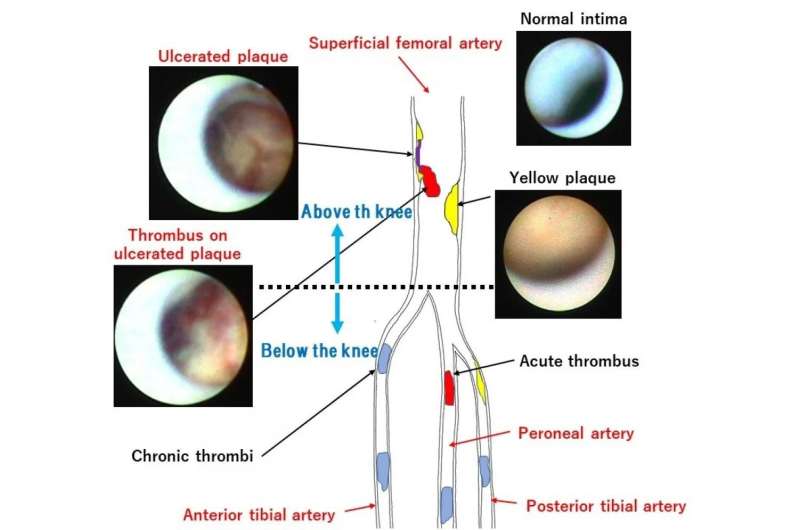Ulcerated plaque is source of arterial embolism in popliteal arteries

A research group the Department of Cardiovascular Medicine, Osaka City University Graduate School of Medicine, has revealed for the first time that the thrombus generated by ulcerated plaque (UP) observed in the femoropopliteal artery (FPA) during angioscopy is the source of embolization of the popliteal artery. The results of this research are expected to help develop the best medical treatment for peripheral arterial disease (PAD).
In patients with PAD, the extent of infrapopliteal lesion is known to be an important factor correlating with prognosis. Recent pathological studies have suggested that embolization by an upstream thrombus is one of the mechanisms for the formation of infrapopliteal lesions, but the location where the thrombus occur in the body had yet been identified.
In a study of 31 patients who underwent endovascular therapy and angioscopy at the Department of Cardiovascular Surgery, Osaka City University Hospital, researchers indentified 23 patients with irregular plaque buildup in the FPA, which they classified as UP. Angioscopic data showed 22 of these patients had mural thrombi in the FPA and on the UP—a ratio which was higher than in patients where no ulcerated plaque was observed. In addition, linear regression analyses revealed that UP was strongly correlated with the angiographic runoff score (ARS), an index reflecting the degree of occlusive stenosis in the popliteal artery. The results of this study were published online in the Journal of Vascular and Interventional Radiology on Monday, 31 January 2022.
"Previous reports used coronary artery findings to determine thrombus formation in the FPAs," states Tomohiro Yamaguchi MD, lead author of the study, "However, this creates complications due to critically different anatomical features among vessels between coronary arteries and FPA."
From this study, the team observed that while the maximum yellow plaque color grade, taken from coronary artery findings, had no significant association with infrapopliteal ARS, the detection of UP was significantly associated with a poor ARS. This suggested a different mechanism for thrombus formation compared with that in the coronary artery.
"Although recent advances in catheterization for PAD have been remarkable, treatment results are still inadequate," states Dr. Takanori Yamazaki, who collaborated in the study. "We believe that a detailed assessment of the nature of plaque in femoropopliteal arteries, as found in this study, will help to explain the mechanism of the disease and develop optimal treatment methods."
More information: Tomohiro Yamaguchi et al, Angioscopic Ulcerated Plaques in the Femoropopliteal Artery Associated with Impaired Infrapopliteal Runoff, Journal of Vascular and Interventional Radiology (2021). DOI: 10.1016/j.jvir.2021.10.013




















